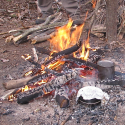First Aid Tip: Burns

Now that Summer is almost here, many of us will be spending more time in the out of doors. That often means either camping, hiking in a local park, or even just lazing around in the backyard (which I fully hope to be doing). While, certainly, the risk of injury in any of these situations is low, problems can manage to arise. So, a little knowledge and preparation can go a long way should something happen. One type of typical outdoor injury is burns, and, in fact, the most common cause arises from cooking accidents.
Whether it is caused by your backyard grill or your camp stove, minor burns to your hands may be caused by inadvertently grabbing hot metal; and potentially major burns may arise from stove flare-ups and scalds from tipping over pots of boiling liquid. In fact, these kind of burns can be more serious than that caused by an open flame of the same temperature because they can transmit heat much faster than air.
What happens when one is burned? Burns can damage or destroy one or more layers of skin directly by heat. If a burn is superficial (commonly known as a 1st degree burn), the skin will redden because of increased circulation of blood to the site, but it will briefly turn white when you press on it (because the blood is forced away), then will quickly turn red again as the blood returns.
In a more serious burn, like a partial thickness burn (commonly known as a 2nd degree burn), several layers of skin are seriously damaged, and the rush of circulation to the damaged layers pushes them apart to form blisters. These kind of burns are especially painful, because the extent of the damage triggers so many nerve endings.
The most serious type of burn is a full thickness burn (commonly know as a 3rd degree burn). Basically, the skin has been cooked so it looks charred, deep red, or white; or it may be burned away, exposing deeper tissues. While the burn site may not actually hurt (because all tissue in the skin, including nerves, has been killed), a partial thickness burn often surrounds it so it can still be extremely painful (which is still potentially somewhat of an understatement).
How does one care for a burn? Should you need to care for a patient that is burned, first aid includes three basic steps.
First, expose and cool the burn.
- Use Body Substance Isolation (BSI) — That is, put on gloves to protect you and your patient from germs.
- Stop burning and remove clothing around burn; if stuck, leave in place.
- Cool burn with water; large partial or full thickness burns should only be cooled enough to put out fire.
Second, cover the burn.
- Cover burn with dry, sterile or clean dressing.
- If evacuation is delayed, change dressings frequently.
- Don’t apply ointments, butter, antiseptic or lotion.
Three, treat for shock.
- Fluid loss from burn will cause shock.
- Consider an occlusive dressing to reduce fluid loss.
- If burn involves face, closely monitor the airway.
- Serious burns should be evacuated as soon as possible.
Summary: In short, burns are a potentially serious injury, especially in the backcountry. Complications such as fluid loss and infection are likely. Recognizing the severity of a burn injury, providing immediate care and getting the patient immediate medical attention are the chief priorities.
Ultimately, though, this article is meant only to provide an introduction to a common outdoor injury so it shouldn’t be construed as medical advice or actual training (which can only be accomplished in first aid class). So, if you spend time outdoors on your own or with friends definitely consider taking a Wilderness First Aid (WFA) certification course. It provides a great way for you to be better prepared to take care of others, and potentially yourself, should the need arise.
After all, as we stress at True North in all of our wilderness survival or wilderness medicine courses, preparation and practice are fundamental to best dealing with any outdoor emergency.
————–
True North offers Wilderness First Aid (WFA), Wilderness First Responder (WFR) and Wilderness EMT Upgrade (WEMTU) certification to both private groups and as open enrollment that are affordable and easy on your busy schedule. To learn more, contact Erik at erik@exploretruenorth.com

